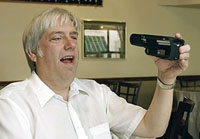A new handheld device for the blind converts print to audio
The National Federation of the Blind (NFB) unveiled a groundbreaking new device - the Blind Reader. The portable Reader, developed by NFB and inventor Ray Kurzweil, enables users to take pictures of and read most printed materials at the click of a button.

The device combines a personal data assistant and a digital camera. It's been dubbed the Kurzweil-National Federation of the Blind Reader.
"This is really the hottest new technology to be developed for blind people in the last 30 years," said Gashel, who calls it "the camera that talks."
"It's not quite like having a pair of eyes that work, but it's headed in that direction, said James Gashel, executive director for strategic initiatives at the Maryland-based National Federation of the Blind.
About three decades ago, Kurzweil came up with the first invention that converted text into audio. It was about the size of a washing machine. That eventually gave way to software that could be paired with a computer and scanner and perform the same function. But the latest device has a big advantage: portability.
There are about 10 million blind and visually impaired people in the United States and that number is expected to double in the next 30 years as baby boomers age, giving the reader a large potential audience.
The federation expects the reader, which costs about $3,500 (euro2,799.55), will be a big hit among the 3,000 participants at the organization's annual meeting, which begins Saturday in Dallas.
It will be sold though Massachusetts-based Kurzweil Education Systems Inc. and will be available via the Internet and in stores across the nation.
Kurzweil said he expects in the future the reader will allow for the deciphering of more complex formats, and over time, identifying objects and people.
For now, those who have tested the reader say they have enjoyed being able to read items they never have before, like the magazines in the pockets of airplanes, the AP reports.
Whether born blind, or in the process of losing your sight in middle age, you need not go without the joys of reading.
Apart from Braille, a number of alternatives are emerging, allowing access to anything from newspapers and novels, to academic journals.
The traditional way
The development of Braille in 1824, by the Frenchman Louis Braille, was something of a Gutenberg moment in the emancipation of blind people. And, for many blind people, Braille remains the default mode of reading.
It is best to learn Braille when you are as young as possible, but,if you lost yoursightlaterin life, it may nevertheless still be worthwhile. Learning Braille is not as difficult as it may seem.
The main problem with Braille is the relatively limited variety of texts available in the medium. Producing a Braille text is both slow and expensive. And, with a limited demand for Braille books, specialised titles are often overseen.
The audio option
A second option is the use of audio formats, and we are not talking about that mediocre shelf of audio books at your local bookstore.
Both the South African Library for the Blind and Tape Aids for the Blind have huge libraries of books read on audiocassette. And, if they cannot find a book for you, they have agreements with overseas libraries that should be able to get it for you.
Though audiocassettes are still being used in South Africa, the move will soon be made to digital formats. In the US and UK books are already being distributed on CDs in compressed formats. This means, that a single CD may contain the full text of a large work such as Crime and Punishment. Special players or computers are however required to play these disks.
The availability of books in audio formats is very impressive, even though it may take a while to get hold of the book you are looking for. The possibility of sharing audio books by means of the internet may well speed the process up in future.
Let your computer do the reading
Advances in so-called text-to-speech software means that just about any text you see on a computer screen can now be turned into audible speech. (And do note that computers no longer speak in the metallic drawl heard in old science fiction films.)
The development of text-to-speech software in conjunction with the explosive growth of the internet has changed things for blind people almost as much as the development of Braille itself.
The entire World Wide Web has been opened to blind people – giving them access to all the information other people can access over the net. And, for people who cannot read normal newspapers or magazines, the difference is huge.
Furthermore, most newly released books are also released as e-books. These can also be read using text-to-speech software, thus making books available to blind people as they are released. In addition, many books that are no longer under copyright are available for free on the internet, Health24.com reports.
Source: agencies
Prepared by Alexander Timoshik
Pravda.ru
Discuss this article on Pravda.ru English Forum
Subscribe to Pravda.Ru Telegram channel, Facebook, RSS!





